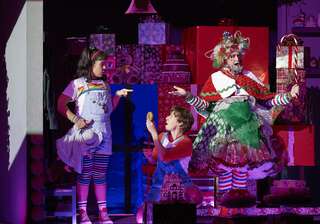|
Back
Puzzles within puzzles Toronto
The Four Seasons Centre for the Performing Arts
02/06/2020 - & February 8, 11*, 15, 16, 19, 21, 2020
Engelbert Humperdinck: Hänsel und Gretel
Simone Osborne (Gretel), Emily Fons (Hänsel), Krisztina Szabó (Gertrude), Russell Braun (Peter), Michael Colvin (The Witch), Anne-Sophe Neher (The Sandman, The Dew Fairy)
The Canadian Children’s Opera Company, Teri Dunn (music director), The Canadian Opera Company Orchestra, Johannes Debus (conductor)
Joel Ivany (director), S. Katy Tucker (set and projection designer), Ming Wong (costume designer), JAX Messenger (lighting designer) 
S. Osborne, E. Fons & M. Colvin (© Michael Cooper)
Of all the people who have emerged within the opera scene in Toronto in the past decade, stage director Joel Ivany occupies a special place with his clever, well-thought-out reworkings of Le nozze di Figaro as Figaro’s Wedding in 2013, then Don Giovanni as #Uncle John in 2015, and Così fan tutte as A Little Too Cosy in 2016. All were performed by Against the Grain Theatre, a company he co-founded and which has been “adopted” as a junior experimental partner to the COC. (He also brought his distinctive energy to a restaging of a main stage repertory work, Carmen, to be repeated in 2021.)
Now he has brought Hänsel und Gretel to the main stage, using the original libretto, but setting it in a contemporary high rise apartment building in Toronto. We are presented with a cutaway view of four apartment interiors plus corridors on two floors. On the lower level is the family’s flat and across the hall that of a man who seems to be the building’s janitor. Above the family lives a frail old man in a place piled high with books. Across the hall on that floor is a young woman with a dog.
Thus a big problem arises: it is totally incongruous that the children’s father, Peter, is a broom-maker, and that the mother sends the kids out into the forest to find strawberries. Instead we see them going door-to-door in the building (where even more floors are cleverly indicated by the lighting scheme) - are they asking for food? for strawberries? for money? The elderly man upstairs welcomes them and his apartment has to do for the forest in which they frighten themselves and then fall asleep. At the same time the parents enlist the janitor in what turns out to be an elaborate ruse in which he pretends to be a witch. They also refashion the apartment into a place for a sleepover by a host of children while Hansel and Gretel bed down in the flat upstairs. The elderly man turns out to be the Sandman, then next morning the Dew Fairy. The next day turns out to be Christmas (!) (when we thought it was strawberry season) and instead of a gingerbread house the children come upon the janitor’s flat piled high with gifts, cakes and other delights. In short, the plot points of the original script have to be strenuously stretched and squeezed to fit the new scenario - and the result is a puzzle with myriad loose ends. It is a pity it wasn’t retitled Johnny and Maggie and then retrofitted with apt lyrics and modern details, although I still don’t know how the kids would deal with the cannibalistic witch/janitor.
Musically it is very strong with Johannes Debus and the orchestra bringing forth much loving detail in the rich score, especially with the winking echoes of Wagner. Simone Osborne and Emily Fons are ideal physically and vocally as the children; the dance they devise for themselves is endearingly goofy. Krisztina Szabó and Russell Braun are well cast as the harried (but then not really) parents. The role of the witch was originally composed for a mezzo-soprano and Michael Colvin’s tenor, despite the healthy ping in his voice, gets covered at moments. Anne-Sophie Neher brings sparkle and warmth to her lovely but brief roles. The Canadian Children’s Opera Company members contribute wonderfully to the work’s glorious conclusion.
Visually it is a treat, thanks largely to S. Katy Tucker’s projections and JAX Messenger's lighting. During the overture we first see a child’s view of planet earth; this zooms down to an overview of Toronto and then an aerial trip ending at the apartment building. At the end of Act I, when the children have sung themselves to sleep, the stage and auditorium are drenched in images of the cosmos. In Act II we are shown a psychedelic blitz of Christmas imagery while the witch appears as a pantomime dame personified as a Christmas tree.
This works fine as an immersion in lush music and visuals. Just don’t try to analyze the drama.
Michael Johnson
|